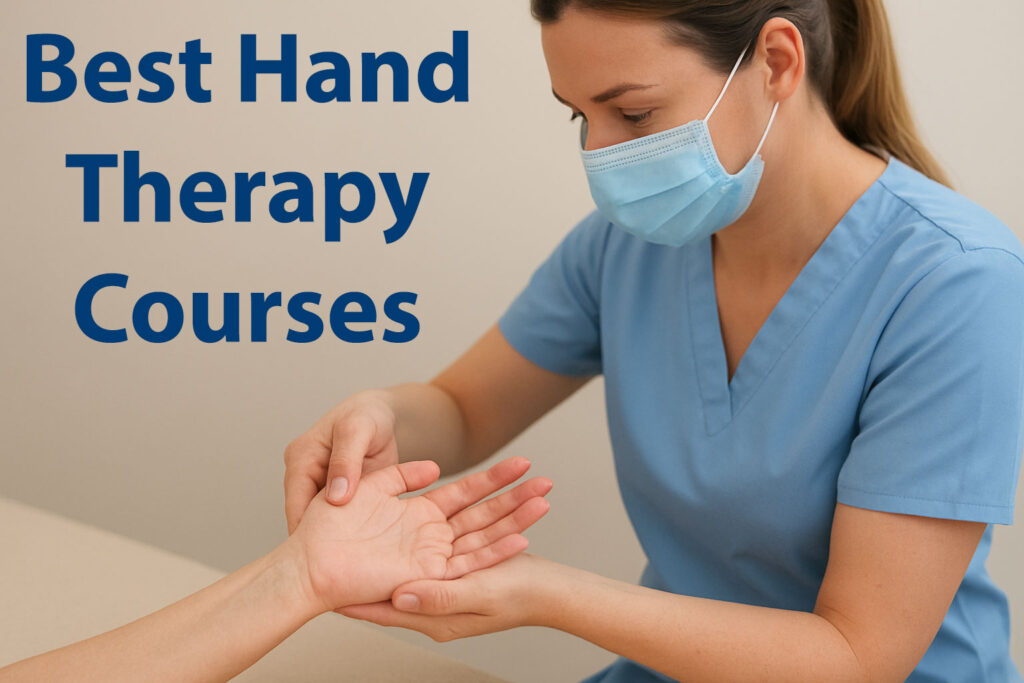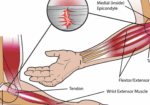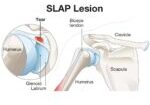Les meilleurs cours de thérapie manuelle pour booster vos compétences et votre carrière
Classé sous Non classé
La rééducation de la main est une spécialisation en plein essor au sein des domaines de l'ergothérapie et de la kinésithérapie. Face à la demande croissante de professionnels formés au traitement des affections des membres supérieurs, la poursuite de ces activités est essentielle. cours de thérapie de la main peut changer la donne pour votre carrière. Que vous soyez un jeune diplômé ou un thérapeute expérimenté souhaitant élargir ses compétences, la formation adaptée peut vous apporter les connaissances, la certification et la confiance nécessaires à votre réussite.

Introduction à la thérapie de la main
Qu'est-ce que la thérapie de la main ?
La rééducation de la main est une spécialité de la réadaptation axée sur le traitement des blessures et affections des mains, des poignets, des avant-bras et des épaules. Elle combine les connaissances de l'ergothérapie et de la physiothérapie pour restaurer la fonction, réduire la douleur et améliorer la mobilité.
Importance de la formation spécialisée en thérapie de la main
Contrairement aux formations thérapeutiques générales, la thérapie de la main requiert des connaissances anatomiques approfondies, des techniques de rééducation spécifiques et des compétences en fabrication d'orthèses. Une formation spécialisée permet aux thérapeutes d'être équipés pour traiter des cas complexes comme les réparations tendineuses, les fractures, l'arthrite et les troubles neurologiques.
Qui devrait suivre des cours de thérapie de la main ?
ergothérapeutes
Les ergothérapeutes recherchent souvent des cours de thérapie manuelle pour obtenir le titre de thérapeute manuel certifié (CHT), améliorant ainsi leurs compétences cliniques et leur crédibilité.
physiothérapeutes
Les physiothérapeutes bénéficient d’une compréhension des subtilités du membre supérieur, ce qui leur permet d’offrir des soins plus complets et d’élargir leur champ de pratique.
Étudiants et nouveaux diplômés
Même les professionnels en début de carrière peuvent commencer leur parcours avec des cours fondamentaux qui les préparent à des certifications avancées plus tard.
Objectifs d'apprentissage clés des cours de thérapie de la main
Anatomie et biomécanique de la main
Les cours explorent en profondeur les systèmes musculo-squelettique et nerveux du membre supérieur, enseignant comment les blessures et les maladies affectent le mouvement et la force.
Techniques de rééducation
Les participants apprennent des méthodes fondées sur des preuves pour l’exercice thérapeutique, la thérapie manuelle et les modalités adaptées aux blessures à la main.
Interventions post-chirurgicales
Une attention particulière est accordée au traitement des patients après des interventions chirurgicales telles que des réparations de tendons ou des remplacements d'articulations, avec des protocoles pour une récupération sûre et efficace.
Cours de thérapie de la main en ligne ou en personne
Avantages et inconvénients de l'apprentissage en ligne
Avantages : Horaires flexibles, accessibilité de partout et coûts souvent inférieurs.
Inconvénients : Manque d’expérience pratique, réseautage limité.
Avantages de la formation pratique
La formation en personne offre une rétroaction en temps réel, des simulations cliniques et des applications pratiques essentielles à la maîtrise des techniques d'attelles et de thérapie manuelle.
Meilleurs programmes de certification accrédités en thérapie de la main
Cours préparatoire au diplôme de thérapeute certifié de la main (CHT)
La référence en matière de certification en thérapie de la main, nécessitant 4 000 heures de pratique clinique et la réussite d'un examen rigoureux.
Cours de l'Académie de thérapie de la main
Réputé pour ses CEU en ligne, HTA propose des cours vidéo attrayants et des outils d'apprentissage interactifs.
Cours à court terme vs. cours à long terme
Ateliers du week-end
Idéal pour des sujets spécifiques comme la fabrication d'attelles ou les évaluations ergonomiques. Idéal pour ceux qui souhaitent se perfectionner rapidement.
Certifications intensives
Les programmes prolongés offrent une plongée plus approfondie, aboutissant à des compétences pratiques avancées et parfois à une préparation à la certification.
Meilleurs cours de thérapie de la main
Soins des plaies en thérapie de la main
Ce cours couvre tout ce que vous devez savoir sur le traitement des plaies dans le cadre de la thérapie de la main.
L'attelle simplifiée
Ce cours de fabrication d'orthèses/attelles couvre 23 types d'attelles différents ! Il comprend un livre électronique avec un guide pratique pour chaque attelle, à utiliser comme ressource rapide en clinique.
Documentation à l'épreuve des balles
La documentation est essentielle à tout ce que nous faisons en thérapie. Ce cours vous permettra de vous assurer que vos notes sont conformes à toutes les normes.
Que rechercher dans un cours de qualité
- Accréditation des cours : Assurez-vous que le cours est reconnu par les conseils professionnels.
- Qualifications de l'instructeur : Recherchez des instructeurs possédant une expertise clinique et académique.
- Travaux pratiques et études de cas : Les applications du monde réel améliorent l’apprentissage et la rétention.
Coûts et budgétisation des cours
Fourchette de prix moyenne
Les prix varient considérablement : les cours en ligne peuvent commencer à $50, tandis que les programmes de certification complets peuvent coûter plus de $1 000.
Bourses d'études et parrainages d'employeurs
Renseignez-vous auprès des employeurs ou des associations professionnelles sur les possibilités de financement ou les programmes de remboursement.
Durée du cours et engagement temporel
Programmes à rythme libre ou programmés
Les cours à rythme libre offrent de la flexibilité, mais exigent de la discipline. Les programmes planifiés offrent structure et responsabilisation, souvent avec des échéances et des interactions entre pairs.
Études de cas et applications réelles
Rééducation post-chirurgicale
Les cours utilisent des exemples tels que la réparation du tendon fléchisseur pour démontrer les délais de rééducation et les protocoles d'attelle.
affections chroniques de la main
Apprenez à gérer des affections telles que la polyarthrite rhumatoïde, le syndrome du canal carpien et le SDRC grâce à des interventions thérapeutiques.
Sujets avancés dans les cours de thérapie de la main
Troubles neurologiques
Découvrez les traitements contre les accidents vasculaires cérébraux, les lésions nerveuses et les troubles neuromusculaires affectant la fonction de la main.
Fabrication d'attelles sur mesure
Formation pratique à la création d'orthèses statiques, dynamiques et statiques-progressives adaptées aux besoins des patients.
Unités de formation continue (CEU) et licences
Unités de formation continue requises pour le CHT
Les thérapeutes doivent acquérir des CEU en continu pour maintenir leur statut de certification et de licence.
Processus de déclaration et de renouvellement
Assurez-vous que vos cours fournissent des certificats pour les CEU et répondent aux exigences du conseil d'État ou du conseil d'examen national.
Témoignages et avis des participants au cours
Histoires de réussite
Les thérapeutes signalent souvent une confiance accrue, de meilleures opportunités d’emploi et de meilleurs résultats pour les patients.
Tendances courantes en matière de commentaires
Les participants apprécient les démonstrations pratiques, les conférences d’experts et les applications pratiques plutôt que le contenu purement théorique.
Opportunités de carrière après l'obtention du diplôme
Cliniques et hôpitaux
Les diplômés décrochent souvent des postes dans des cliniques orthopédiques, des unités de réadaptation chirurgicale et des départements de thérapie de la main.
Pratique privée
Des connaissances spécialisées permettent la création de cabinets privés spécialisés dans la réadaptation des membres supérieurs.
Enseignement et recherche
Les apprenants avancés peuvent passer au monde universitaire ou à la recherche clinique, contribuant ainsi à l’ensemble des connaissances en thérapie de la main.
Foire aux questions (FAQ)
1. Comment devenir thérapeute de la main ?
Pour devenir un thérapeute de la main certifié (CHT), vous devez être un ergothérapeute ou un physiothérapeute agréé, effectuer 4 000 heures d'expérience directe en thérapie de la main et réussir l'examen CHT.
2. Les cours de thérapie de la main en ligne sont-ils reconnus ?
Oui, de nombreux cours en ligne de fournisseurs accrédités comme Hand Therapy Academy sont acceptés pour les CEU et la préparation au CHT.
3. Qu'est-ce que l'examen CHT ?
L'examen de thérapeute de la main certifié est un test complet administré par la Commission de certification de la thérapie de la main (HTCC) qui évalue les connaissances cliniques avancées et leur application.
4. Puis-je suivre ces cours à l’étranger ?
Absolument ! De nombreux prestataires proposent un accès mondial aux cours en ligne. Vérifiez toutefois s'ils répondent aux exigences de licence ou de certification de votre pays.
5. Ces cours comptent-ils pour les CEU ?
La plupart des cours professionnels sont accrédités et comptent pour vos unités de formation continue (CEU) requises pour le renouvellement de votre licence ou votre certification.
6. Combien de temps faut-il pour obtenir la certification ?
Il faut généralement quelques années après l'obtention de la licence pour accumuler les 4 000 heures cliniques requises pour l'examen CHT, plus du temps supplémentaire pour la préparation et l'étude des cours.
Conclusion : choisir le cours de thérapie de la main qui vous convient
Choisir la formation en thérapie manuelle adaptée dépend de vos objectifs de carrière, de votre disponibilité et de votre style d'apprentissage. Que vous souhaitiez obtenir la certification CHT ou simplement améliorer vos compétences en thérapie manuelle, il existe une formation adaptée à votre parcours. Évaluez les options en fonction du contenu, de la crédibilité, du coût et de la flexibilité, et préparez-vous à transformer votre pratique et les résultats pour vos patients.
Plus à lire
Pourquoi l’épuisement professionnel se produit en thérapie de la main et ce que nous pouvons faire à ce sujet.
Pourquoi le burn-out survient-il en kinésithérapie ? Plusieurs raisons peuvent expliquer le burn-out, notamment chez les professionnels de santé. Comment y remédier ? Conclusion : Le burn-out n'est pas un échec personnel, mais souvent un problème systémique. Mais nous avons le pouvoir de réagir. En tant que kinésithérapeutes, nous sommes experts en…
En savoir plusTennis Elbow et exercices gradués
Douleur latérale au coude avec exercice progressif Tennis elbow chronique avec protocole d'exercices progressifs supervisés Özdinçler, AR, Baktır, ZS, Mutlu, EK et Koçyiğit, A. (2023). Tendinopathie latérale chronique du coude avec un protocole d'exercices progressifs supervisés. Journal de thérapie de la main, 36(4), 913-922. https://doi.org/10.1016/j.jht.2022.11.005 The Skinny : Cette étude a examiné l'efficacité d'un…
En savoir plusComment améliorer les compétences en traduction motrice fine
Par : Josh MacDonald Les bases – Je dépose une pile de petits objets sur la table et un conteneur ouvert dans lequel le client peut les mettre. L'objet que j'utilise dépend du niveau du client. Nous y reviendrons plus tard. Ensuite, ils utilisent une pince à 2 pointes pour en saisir une et la déplacer…
En savoir plusQu'est-ce qu'une déchirure par claque ? Déchirure antérieure à postérieure du labrum supérieur
Qu'est-ce qu'une lésion SLAP ? Une lésion labrale supérieure, antérieure et postérieure (SLAP) est une lésion affectant la partie supérieure du bourrelet glénoïdien, là où le tendon du chef long du biceps est ancré (Levasseur et al., 2021). La déchirure survient généralement en arrière et s'étend en avant au niveau de l'encoche glénoïdienne moyenne, qui peut être examinée par arthroscopie de l'épaule (Kim et al.).
En savoir plusInscrivez-vous pour recevoir des mises à jour directement dans votre boîte de réception !
Inscrivez-vous avec nous et nous vous enverrons régulièrement des articles de blog sur tout ce qui concerne la thérapie des mains, des notifications chaque fois que nous mettons en ligne de nouvelles vidéos et tutoriels, ainsi que des documents, des protocoles et d'autres informations utiles.






